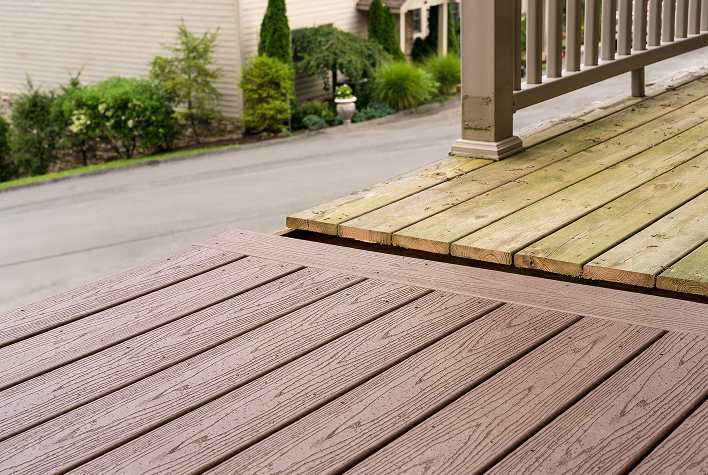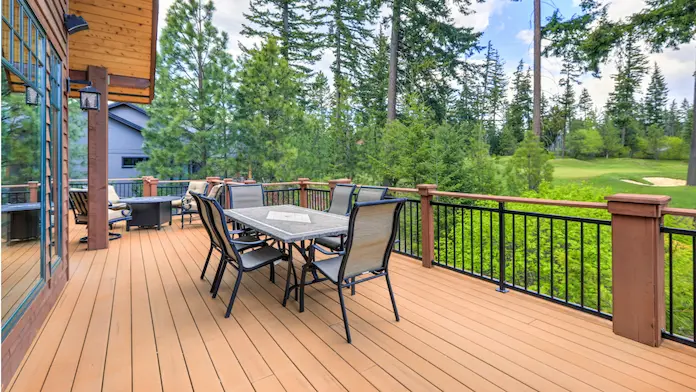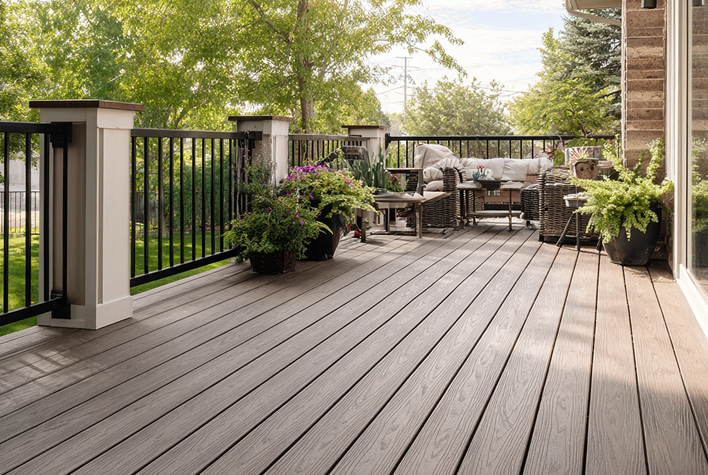
Key Points
- For most homeowners in the U.S., the average deck installation cost will be $4,000 to $12,000, with the national average sitting around $7,500.
- The price can vary depending on factors like materials, size, design complexity, and labor.
- You can reduce costs by doing some work yourself.
In this article, we’ll break down the specific costs, including materials, labor, and other expenses, as well as explore ways to save money without sacrificing quality. Whether you’re planning a small deck or a large one, you’ll find the information you need to make informed decisions. Read on to learn more about building your dream deck!
Factors that Affect Decking Pricing

When planning to build a deck, keep in mind the factors that can significantly affect the overall cost. Understanding them can help you budget effectively and make informed decisions. Let’s delve into each factor in detail:
Deck Size
The deck size is the main cost factor. Larger decks require more materials and labor, which increases the overall price. Prices typically range from $40 to $75 per square foot, including materials and labor.
Materials
The choice of decking material is one of the most significant cost factors. Different materials vary in durability, maintenance requirements, and aesthetic appeal. Here are some materials you can use:
| Material | Price per Square Foot | Pros |
|---|---|---|
| Pressure-Treated Wood | $15 - $25 | The most affordable and widely available option but may require regular maintenance |
| Cedar or Redwood | $25 - $35 | Natural woods with better resistance to rot and insects, with an attractive look |
| Composite | $25 - $45 | Low maintenance, resistant to rot and insects |
| PVC (Vinyl) | $30 - $60 | Excellent durability, low maintenance, resistant to weather conditions |
| Aluminum | $40 - $70 | Extremely durable, rust-resistant, lightweight |
| Ipe (Brazilian Hardwood) | $30 - $60 | Extremely durable, resistant to insects and decay, and luxurious design. However, it can be challenging to work with |
| Bamboo | $20 - $40 | Eco-friendly and durable solution, a highly renewable resource |
| Mahogany | $30 - $50 | Beautiful, strong, and durable material |
| Fiberglass | $25 - $50 | Lightweight, water-resistant material requiring very little maintenance |
| Recycled Plastic | $30 - $50 | Eco-friendly, resistant to rot and insects |
Design Complexity
A simple rectangular deck is less expensive to build than a multi-level deck with intricate patterns or built-in features like benches and lighting. Custom designs typically add an extra $5 to $10 per square foot to the overall price.
The basic design includes a simple rectangular or square shape. The construction is single-level, with a basic railing design. Its price range is $15 to $30 per sq. ft.
The complex design includes multi-level decks, unusual shapes or curved edges, built-in features like benches or planters, or intricate railing designs. Its price range is $35 to $60+ per sq. ft.
Complex designs often require more skilled labor and additional materials, driving up costs.
Labor Costs
If you hire professionals, labor can account for 50% to 60% of the total cost. Labor costs to build a deck also depend on the location and contractors’ experience. The price will vary depending on your region and the local demand for contractors. Also, highly experienced and reputable contractors may charge more, but their expertise can ensure a high-quality finished product.
For professional installation, labor rates range from $8 to $22 per square foot, depending on the complexity of the project and your location. Keep in mind that if you decide to install a deck yourself, you can save on labor costs, but you’ll need the right skills and tools to ensure quality.
Permits and Inspections
Depending on where you live, you may need to get permits before building a deck. Permit fees vary by location but typically range from $100 to $500. Inspections may also be required, adding further costs. Some areas may require multiple inspections throughout the building process.
Foundation and Site Preparation
If you build your deck on uneven ground or it requires additional support structures, foundation, and site preparation, approximate deck cost can increase. For instance, installing concrete footings or piers can cost between $80 and $200 per footing. If grading or clearing the site is needed, expect to pay an additional $800 to $3,000, depending on the extent of the work.
Preparation works may include:
Seasonal Factors
Deck construction costs can fluctuate based on the time of year:
Geographic Location
Labor and material costs vary by region:
Additional Features
You can customize your deck with various add-ons:
Finishing and Maintenance
Finishing touches, such as staining, painting, or sealing, can add another $800 to $2,500 to the total cost. Some materials, like composite or PVC, require little to no maintenance, while wood decks will need periodic sealing and staining, which can cost about $500 to $1,000 every few years.
Deck Building: Ongoing Costs

After you’ve built your deck, ongoing costs are an essential part of maintaining its appearance, safety, and durability. Let’s consider some possible ongoing costs.
Cleaning and Maintenance
All decks, no matter what they are made of, require cleaning to remove dirt, debris, and mildew. You’ll want to clean your deck at least once or twice a year. You can use a deck cleaner and a pressure washer, or you can hire a professional. Professional cleaning costs between $150 to $400.
Staining, Sealing, and Painting (For Wood Decks)
Wood decks need to be regularly stained or sealed to protect them from moisture, UV damage, and rot. Most wood decks need to be resealed or stained every 2 to 3 years. If your deck is painted, it may need repainting every 3 to 5 years to maintain its appearance. Buying a quality stain or sealer costs around $30 to $60 per gallon, with most decks requiring 2 to 4 gallons. The DIY staining or sealing typically costs from $100 to $300. Professional service can cost between $500 and $1,500.
Deck Repairs
Over time, decks may need repairs due to weather damage, wear and tear, or age. Common repairs include replacing damaged boards, fixing loose railings, and addressing structural issues.
Pest Control (For Wood Decks)
Wood decks, especially made of pressure-treated or untreated wood, are susceptible to termites and other wood-boring insects. Regular pest inspections and treatments are recommended to prevent infestations. Annual pest control treatment costs from $100 to $300.
Deck Furniture and Accessories
While not essential for maintenance, adding outdoor furniture, cushions, and other accessories can enhance the functionality of your deck. You may also want to replace or update these items over time.
Lighting and Electrical Maintenance
If your deck has built-in lighting or other electrical components, such as outlets or heaters, occasional maintenance may be required to keep everything functioning properly.
Insurance
Some insurance policies may cover damage to your deck, but in some cases, you may need to increase your coverage or add an endorsement. Adding or increasing coverage for a deck may raise your premium by about $50 to $200 annually, depending on your provider and the deck’s value.
Winter Preparation
If you live in an area that experiences harsh winters, protecting your deck from snow, ice, and freezing temperatures is essential.
Should You Build a Deck Yourself or Hire a Pro?
- Cost - Lower upfront cost (no labor fees); materials only
- Skill Level Required - Requires basic to advanced carpentry skills
- Time Investment - High; could take weeks or months depending on your schedule
- Tools and Equipment - Must purchase or rent necessary tools
- Quality of Work - May vary based on experience
- Permits and Inspections - Must handle permits and inspections yourself
- Customization - Limited by your skill level and experience
- Risk of Mistakes - Higher risk of mistakes, which could lead to costly repairs
- Resale Value Impact - May lower resale value if not done correctly
- Cost - Higher cost (labor + materials); may offer warranties
- Skill Level Required - Professionals have the necessary experience and knowledge
- Time Investment - Faster completion, often within a week or two
- Tools and Equipment - Professionals have all the necessary tools
- Quality of Work - High-quality work with professional standards
- Permits and Inspections - Professionals manage permits and inspections
- Customization - Experts can create complex, customized designs
- Risk of Mistakes - Lower risk due to professional experience
- Resale Value Impact - Increases home value with professional construction
If you choose to hire a pro, follow these steps to find a reputable deck builder:
Homebuddy.com offers a convenient way to find qualified deck builders in your area. Here’s why it’s worth considering:
To begin, just enter your project details and location, and you’ll be matched with top-rated deck builders in your area.
Saving Tips on Building a Deck
Building a deck can be a significant investment, but there are several ways to reduce the cost of putting in a deck without sacrificing quality. Here are some practical tips to help you save money on your project:
Conclusion
Building a deck is an investment that can significantly enhance your outdoor living space and increase the value of your home. While costs can vary depending on several factors, careful planning, smart choices, and regular maintenance can ensure you create a beautiful and functional deck that fits your budget and lifestyle. Remember, a well-built deck provides years of enjoyment and becomes a cherished gathering place for family and friends. So, take the first step, gather information, and start planning your dream deck today!
Frequently Asked Questions
Will a new deck add to the home value?
Yes, building a deck can significantly increase your home’s value, providing a return on investment of approximately 45% to 55% upon resale, depending on the material used and local market conditions.
What is the deck lifespan?
A wooden deck typically lasts between 10 to 25 years, while a composite deck can last from 25 to 50 years. The lifespan depends on the materials used, the quality of construction, and maintenance practices.
How long can I expect to build a deck?
The construction time for a deck varies based on its size and complexity. A simple deck can take about 5 to 7 days, while larger and more intricate designs may require 2 to 4 weeks.
What is the most affordable material?
Pressure-treated wood is generally the most affordable decking material, costing less upfront compared to other options like composite or exotic hardwoods. However, over time, it may require more servicing.


